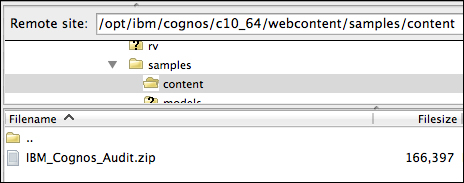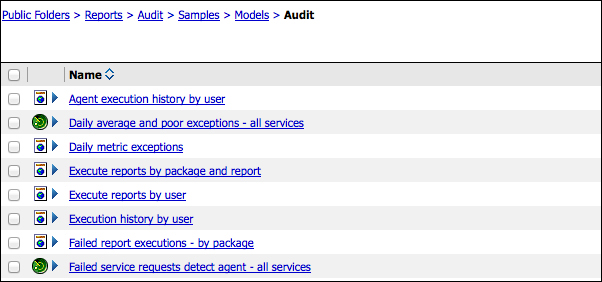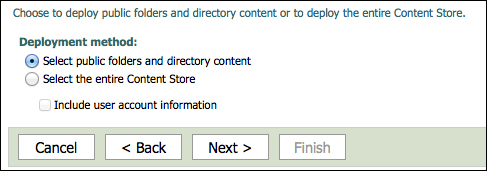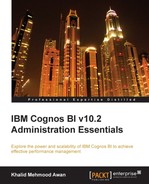To avoid a disaster or to go back in time, we must have the most recent copies of our data that includes the content store (database), configurations (cogstartup<date/time-stamp>.xml), the cryptographic key directories, framework manager projects, images stored in web contents, logfiles, and so on.
Performing regular backups is mandatory, and it is the responsibility of the Cognos administrator to save backups of each of the preceding items in a secure place. The developers also need to have a backup copy of all their projects (packages and reports). This will prevent loss of data. Once a problematic machine is replaced, the data can be easily restored back to the server.
To back up the content store database, the DBA (Database Administrator) may schedule the backup depending upon the frequency required. The content store may also be automatically backed up and replicated if there is more than one Content Manager in the environment. Of course one Content Manager will be working as active and the remaining will be functioning as Standby Content Managers.
The configurations directory within the Cognos BI installation path is equally important as it saves critical configurations for the whole environment. This directory may be copied and pasted to a location on the same machine as well as on a backup secure storage.
Developers and modelers are required to keep framework manager projects either in source-safe control or in a secure, remote location each time they make changes to the model and packages.
Cognos contents may also be saved in the form of deployment exports. The following procedure explains both exporting and importing contents along with certain important options that are supplied in the deployment wizards.
Let's import one of the built-in samples that Cognos BI provides. The following screenshot shows the path where the samples are located. The Cognos_Audit_Log.zip sample will be copied to the deployment folder of the Cognos BI environment.

From the preceding path, the
IBM_Cognos_Audit.zip file needs to be copied and pasted to the deployment folder. The following screenshot shows the deployment archive path where we need to place the sample archive:

The Content Administration section resides under the Configuration tab in the Cognos BI Administration portal as shown in the following screenshot. The folders seen in the screenshot are created for convenience and organizing content exports and import archives. This area is blank otherwise. The archive files that were either exported or imported once can be seen in the following screenshot. The icons are different for both types of files. The Cognos audit sample archive will not be visible here unless we import it once.

There are several options, for example, import, export, index, maintenance, and so on. We will only focus on the import and export functionalities that are relevant to this chapter title. There is a toolbar in the top-right corner of the content management screen, as shown in the following screenshot. Click on the New Import option.

The preceding audit archive will become viewable and selectable as shown in the following screenshot. Select it and click on Next.

Once the Next button is clicked, the archive will be uncompressed by Cognos BI Server at the backend, and all its contents will be shown on the next screen as shown in the following screenshot. There are other options as well, but let's keep the default options on each page of the wizard.

On the last page of the wizard, also viewable in the following figure, there is an option to upgrade the report specifications. This may be selected if we are importing an archive that was created in an older version of Cognos, for example, prior to Version 10.2.

Once the job has been started, it takes some time depending upon the size as well as the nature of the contents included in the archive file that needs to be imported. Roughly, this time is less than a minute. The following screenshot provides a summary of the import process once it is completed. The warnings, failures, information, time, status, and certain other flags are displayed on this screen.

The contents have been imported under Public Folders (as shown in the following screenshot) with the name Samples. The directory administrators may specify permissions to only relevant users once the import process has been completed.

End users (administrators in this case) may use these reports to monitor servers and user sessions, and these reports will also help in capacity and license planning for the Cognos BI Server' environment. A few of the contents (reports and events) are visible in the following screenshot. These contents were part of the archive that we just imported. There are two events and six reports.

The Cognos Content Management section in the Administration portal is a key feature and is used to back up content as well as to deploy contents from the development to the production environment. This job may also be scheduled to dump a selected or complete content store backup on a defined frequency. The New Export option is visible in the following screenshot:

On selecting the New Export option, a wizard similar to the Import Wizard starts asking for information. All the screens and options are self-explanatory as the description is written for each option. Let's rename the export process as Test Import and the description may be specified. The following screenshot gives a snapshot of the first step of the export wizard:

The next step is to select the method of deployment. The Export wizard gives a default option to select the public folders and directory contents manually. It also gives the option to export the entire content store either with the user account information or without it. This second option is useful for taking either a backup of the entire content or when shifting from one server to another server as it also carries the user's account information. In the first option, the administrator needs to explicitly select the content that needs to be exported. The following screenshot shows both the options for deployment method as well as their nested options:

Selecting the Select the entire Content Store option including user account information is a useful way to back up the content store, so it can easily be restored later on if required. The wizard is quite flexible for selecting content multiple times. Folders and package folders are the two content types that can be selected. This means the content that needs to be exported must be enclosed in a folder. All content, subfolders, and their contents are automatically selected. The following screenshot shows the content selection page where the Samples folder has been selected:

In the following screenshot, the wizard is asking if this deployment job needs to be run immediately or at a specific time. This option is imported because if the deployment job contains too much content, it will degrade system performance if run during working hours.

Finally, when the Run button is clicked on in the preceding step, Cognos starts to export all the specified content to a deployment archive, that is a compressed file. After the completion of the process, the deployment wizard shows the summary of the process with all the details of the process status, completion time, and so on. The following screenshot shows the summary of the export process. The ZIP archive is placed at <Cognos_install_path>/deployment folder.

